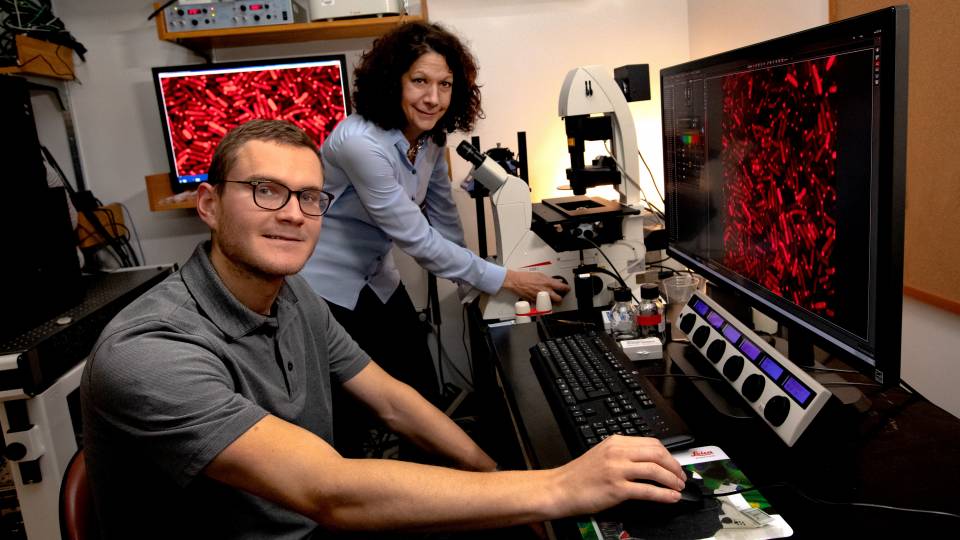A team of Princeton scientists has discovered a key mechanism in how bacteria communicate with each other, a pivotal breakthrough that could lead to treatments for cholera and other bacterial diseases.
The mechanism is a chemical that cholera bacteria use for transmitting messages to each other, known as CAI-1, and has been isolated in the lab of molecular biologist Bonnie Bassler. Her team has shown that the chemical also can be used to disrupt the communication that exists among the bacteria, potentially halting the disease's progress. The discovery could lead to an entirely new class of antibiotics.
"Disease-causing bacteria talk to each other with a chemical vocabulary, and now we can interfere with their talk to control infections," said Doug Higgins, a graduate student in Bassler's lab and first author of the research team's paper on the findings. "This paper specifically concerns cholera, but it provides proof in principle that we can do it with any bacteria."
By exploring how the bacteria's communication informs their group behavior, the team was able to pinpoint a chemical means of sabotaging the conversation. The team's paper appears Nov. 14 in the online edition of the scientific journal Nature.
The findings represent the latest advance in science's attempt to understand the effects of quorum sensing, a relatively new topic in bacterial study. Quorum sensing, which Bassler's lab has explored for more than a decade, concerns the ability of single-celled bacteria to perceive that they are surrounded by a dense population of other bacteria. They communicate their presence by emitting chemical messages that their kin recognize. When the messages grow strong enough, the bacteria respond en masse, behaving as a group.
Some of the group behaviors of these tiny organisms are fairly harmless, such as forming a thin, widely spread colony on a pond's surface -- a colony scientists call a biofilm. These biofilms also form in the human intestinal tract, where many bacteria coexist peacefully with the body, aiding in digestion. However, some bacteria are less benign, like cholera, a disease commonly acquired by drinking contaminated water. When a cholera biofilm forms in the intestines, the bacterial invaders are only hours from the most devastating stage of their infection.
"Forming a biofilm is one of the crucial steps in cholera's progression," said Bassler, the Squibb Professor in Molecular Biology and head of the research group. "They cover themselves in a sort of goop that's a shield against antibiotics, allowing them to grow rapidly. When they sense there are enough of them, they try to leave the body."
Cholera bacteria use the human intestines as a breeding ground, and after enough cholera bacteria have grown there, they seek to escape and find other creatures to infect. They detach themselves from the intestines and benefit from the accumulation of toxins they release into the body. These toxins irritate the body, and it attempts to flush the bacteria out with vomiting and diarrhea. So violent is the effect that if the body is not quickly rehydrated, a victim can die within a day.
Bassler's team realized that the cholera must be signaling each other with some unknown chemical when the time was right to stop reproducing and exit the body. But no one before had found it.
"We generically understood that bacteria talk to each other with quorum sensing, but we didn't know the specific chemical words that cholera uses," Bassler said. "Doug (Higgins) led the hard work that was necessary to figure that out."
Higgins isolated the CAI-1 chemical, which occurs naturally in cholera. Then, Megan Pomianek, a graduate student in the laboratory of Martin Semmelhack, a professor of chemistry at Princeton, determined how to make the molecule in the laboratory. Higgins used this chemical essentially to control cholera's behavior in lab tests.
The team found that when CAI-1 is absent, cholera bacteria act as pathogens. But when the bacteria detect enough of this chemical, they stop making biofilms and releasing toxins, perceiving that it is time to leave the body instead.
"Our findings demonstrate that if you supply CAI-1 to cholera, you can flip their switches to stop the attack," Higgins said.
Chemist Helen Blackwell of the University of Wisconsin-Madison praised the study, calling it a breakthrough for quorum sensing research, and possibly for medical science.
"Lots of other bugs like staph, strep and E. coli use the same general type of signaling mechanism as cholera," said Blackwell, an assistant professor of chemistry. "Many people are looking for ways to inhibit the signaling process, and you could imagine using this process to turn off cholera. It suggests a direct pathway into the clinic."
The field is still far from possessing a complete dictionary of the bacterial chemical lexicon, Bassler said, and this lexicon must be better understood before clinical applications can be developed. But the findings are encouraging.
"We have to show that CAI-1 can cure cholera in lab mice," she said. "We'd also like to understand the chemistry of how the molecule is made in the cell. Meanwhile, the best cure for cholera is to provide the world with clean water."
Contributors to the paper include Dartmouth Medical School's Ronald Taylor as well as Princeton's Semmelhack and Christina Kraml. Funding for the team's research was provided by the Howard Hughes Medical Institute, the National Institutes of Health and the National Science Foundation.


